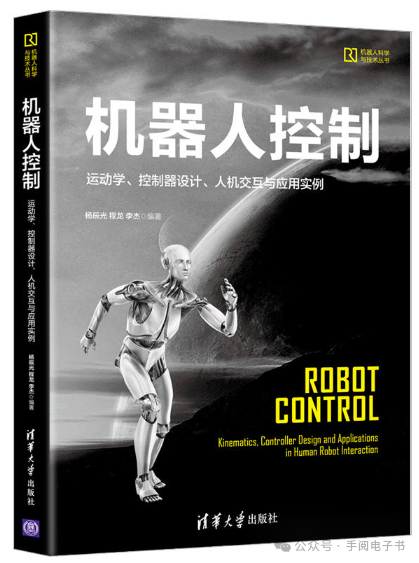 Authors: [China] Yang Chengguang, Cheng Long, Li JiePublisher: Tsinghua University PressPublication Date: August 2020
Authors: [China] Yang Chengguang, Cheng Long, Li JiePublisher: Tsinghua University PressPublication Date: August 2020
Editor Recommendation
This book combines theory with practice and is a relatively rare complete series on robot control, covering everything from basic knowledge to practical applications. Beginners can learn the fundamental theories of robot control, while researchers in related fields can access advanced technologies in robot control through this book, making it suitable for robot enthusiasts at different levels.Target Audience: Senior undergraduate and graduate students in automatic control and computer-related majors, as well as university teachers; robot R&D personnel and related engineering technicians.
Content Summary
Currently, most similar books focus on introducing and researching theoretical knowledge related to robot control, which is quite abstract and does not effectively cultivate readers’ hands-on abilities, making it difficult to achieve good practical results. “Robot Control: Kinematics, Controller Design, Human-Machine Interaction, and Application Examples / Robot Science and Technology Series” emphasizes the combination of theory and application, striving to enable readers to quickly master robot control technology and understand its main research directions.
The book is divided into three parts: the foundational part, the theoretical part, and the application part. The first part serves as the foundation of robot control, starting with the basic theories of robotics and introducing relevant foundational theoretical knowledge; the second part presents commonly used control methods for robots through specific design examples; the last part elaborates on the application of robot control technology in human-machine interaction.
Author Biography
Yang Chengguang, Director of the Guangdong Intelligent System Control Engineering Technology Research Center, selected for the National Youth Talent Program, and a participant in the EU “Marie Curie” Individual Scholars International Introduction Program. He pioneered the variable impedance control method for humanoid robots, receiving the IEEE Transactions on Robotics Paper Award in the robotics field, as well as over ten international conference paper awards including the IEEE Information Automation Annual Conference. He is recognized as a highly cited scientist by Clarivate Analytics and serves as a senior member of IEEE and an editorial board member for several well-known international journals such as IEEE Transactions.
Table of Contents
Part One: Foundational PartChapter 1: Mathematical Foundations of Robotics1.1 Pose Description of Rigid Bodies1.1.1 Position Description1.1.2 Attitude Description1.1.3 Description of Coordinate Systems1.2 Coordinate Transformation1.2.1 Translation Coordinate Transformation1.2.2 Rotation Coordinate Transformation1.2.3 General Coordinate Transformation1.3 Homogeneous Transformation1.3.1 Homogeneous Transformation Matrix1.3.2 Inverse of the Homogeneous Transformation Matrix1.4 Motion Operators: Translation, Rotation, and Transformation
Show all information
Foreword
With the advent of the “Industry 4.0” era, the replacement of some manual labor with robots and intelligent manufacturing has become a trend. The robot controller is a device that controls the robot to perform certain actions or tasks based on instructions and sensor information; it is the heart of the robot, determining the performance quality of the robot. Currently, due to significant advancements in artificial intelligence, computer science, sensor technology, and other related disciplines, research in robot technology is being conducted at a high level, while also placing higher demands on the performance of robot controllers. For different types of robots, such as bipedal walking robots and articulated industrial robots, the comprehensive methods of control systems differ significantly, and the design schemes of controllers also vary.Traditional books in the field of robot control mostly focus on introducing and researching theoretical knowledge of robot control, which can be quite abstract for readers. This knowledge is difficult to cultivate students’ hands-on abilities, making it challenging to achieve good practical teaching results. This book emphasizes the combination of theory and application, striving to enable readers to quickly master robot control technology and understand some mainstream research directions in the field of robot control. The book combines the theory and application of robot control, providing a brief overview of the theory while focusing on introducing application examples of robot control methods.Most of the content in this book uses various robotic arms as controlled objects, and the control methods introduced are mostly selected from the author’s recent publications in high-level international journals and conferences, representing some of the more advanced or mainstream control methods in the field of robot control in recent years. Some control methods are also selected from typical methods in related books on robot control, with improvements and supplements made to varying degrees. In specific application scenarios, through detailed theoretical explanations of different controller design methods and analysis of simulation/experimental results, the abstract and difficult-to-understand control theories are made easier to comprehend and master, facilitating deeper research for interested readers.
Show all information
Media Comments
This book combines theory with practice, thoroughly explaining the robot control theory from foundational knowledge to practical applications. Beginners can learn the basics of robot control from it, while researchers in related fields can access advanced technologies in robot control, making it suitable for robot enthusiasts at different levels.—— Chen Yiming, Academician of the Singapore Academy of Engineering, IEEE Fellow, ASME Fellow, Professor at Nanyang Technological University, SingaporeThis book is a practical and cutting-edge work in the field of robot control. It not only covers the basic theories related to robot control but also delves deeper into the author’s latest research results in this direction, presenting the content in a gradual manner, making it a rare gem!—— Shi Yang, Academician of the Canadian Academy of Engineering, IEEE Fellow, ASME Fellow, Professor at the University of Victoria, CanadaThis book introduces the design methods and application examples of robot controllers in a detailed manner from foundational, theoretical, and application perspectives.

Customer Service WeChatPre-sales ConsultationAfter-sales Service